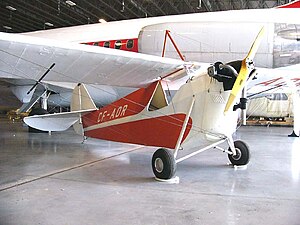Aeronca C-2
| Aeronca C-2 | |
|---|---|
 |
|
| Aeronca C-2 in the Canada Aviation and Space Museum | |
| Role | Monoplane |
| National origin | United States |
| Manufacturer | Aeronca Aircraft |
| Designer | Jean A. Roche |
| First flight | 1929 |
| Number built | 164 |
| Unit cost |
$1495 in 1929
|
| Developed from | 1925 Roche Monoplane |
| Variants | C-1 Cadet, Aeronca C-3 Master |
The Aeronca C-2 is an American light monoplane designed by Jean A. Roche and built by Aeronca Aircraft.
Jean A. Roche was a U.S. Army engineer at McCook Field airfield in Dayton, Ohio. Roche developed an aircraft with automatic stability and was granted U. S. Patent No. 1,085,461. Roche published his engineering ideas for the aircraft in Aerial Age Weekly and Slipstream Monthly magazines. The prototype was started in Ohio in 1923 with the assistance of fellow engineer Quienten Doshse. The aircraft used a triangular cross-section welded steel tube fuselage, with wood wings, was fabric-covered, and used wire bracing throughout. A Henderson engine was installed, but did not perform well. Next a custom 29 hp two-cylinder Morehouse engine was developed for the aircraft. On September 1, 1925 the aircraft was successfully test flown. Many pilots including Jimmy Doolittle tried out the aircraft. Wright Aeronautical hired Morehouse and rights to his Wright-Morehouse WM-80 engine. Left without an engine, They turned to Robert E. Galloway of the Aeronautical Corporation of America to use the Aeronca E-107 engine. The rights to the aircraft were sold to Aeronca in 1928 as the basis for the C-2 Design.
The Aeronca C-2, powered by a tiny two-cylinder engine, made its first flight in October1929, with its public debut in St. Louis in February 1930. It was flying at its most basic—the pilot sat on a bare plywood board. The C-2 featured an unusual, almost frivolous design with an open-pod fuselage that inspired its nickname, The Flying Bathtub. (It was also nicknamed "Airknocker" and "Razorback".) The general design of the C-2 could have been inspired by Jean Roche's initial flight experiences with an American-built copy of the Santos-Dumont Demoiselle, which had a similar triangular "basic" fuselage cross-section, and wire-spoked main landing gear wheels against the fuselage sides.
Equipped with only four instruments (altimeter, oil temperature, oil pressure, and tachometer), a stick, and rudder pedals (brakes and a heater at extra cost), the C-2 was priced at a low $1,555 (later US$1,245), bringing the cost of flying down to a level that a private citizen could perhaps reach. Aeronca sold 164 of the economical C-2s at the height of the Great Depression in 1930-1931, helping to spark the growth of private aviation in the United States.
...
Wikipedia
